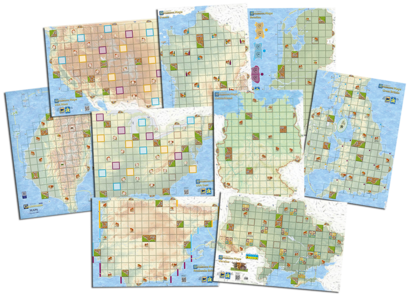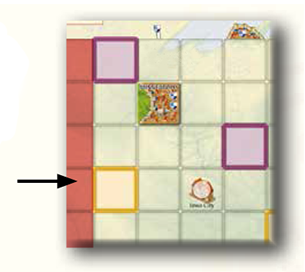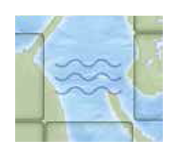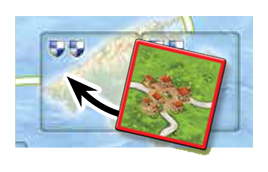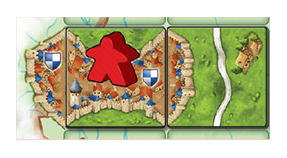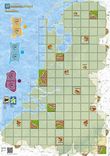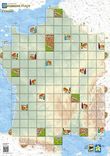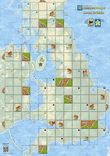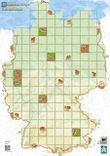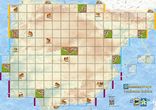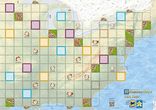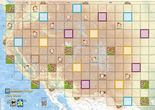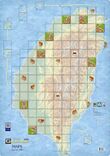Difference between revisions of "Carcassonne Maps - Basic Rules"
Meepledrone (talk | contribs) m (Updated section header) |
Meepledrone (talk | contribs) m (Removed offending tag) |
||
| Line 435: | Line 435: | ||
'''Carcassonne Maps - Taiwan''' | '''Carcassonne Maps - Taiwan''' | ||
Total Maps: 1 | Total Maps: 1 | ||
{{BeginBlockList|600px}} | {{BeginBlockList|600px}} | ||
Revision as of 04:47, 26 September 2021
Main Page > Carcassonne Maps > Carcassonne Maps - Basic Rules
General info and comments
Carcassonne Maps was originally released by HiG in 2019 starting with the map of Germany. Later the same year, additional maps were released: Benelux, France, Great Britain and the Iberian Peninsula (titled Península Ibérica). They were followed by two more maps in 2020: USA East and USA West.
Additionally, Swan Panasia released the map of Taiwan in 2021.
Carcassonne Maps provide a variant for the new edition that offers players a new possibility to play Carcassonne by placing tiles on a map. HiG suggest some rules variations, but encourage players to design their own too.
Contents
- 1 Carcassonne Map (or 2 Carcassonne Maps if combining the USA Maps).
- In addition, you need:
- Tiles: It is recommended to play with the basic game tiles and the first and second expansions, that is, Exp. 1 - Inns and Cathedrals and Exp. 2 - Traders and Builders. [1] Players can combine everything they want to try. For each map there is a recommendation of a number of tiles to be used. It is better to play without the additional rules and meeples of the expansions and to use only the tiles.
- The number of tiles recommended for each map differs:
- Benelux: 110-120 tiles
- France: 110-120 tiles
- Germany (Deutschland): 110-120 tiles
- Great Britain: 90-100 tiles
- Iberian Peninsula (Península Ibérica): 110-120 tiles
- USA West: 110-120 tiles
- USA East: 110-120 tiles
- USA West + USA East: 220-240 tiles (You will need twice as many tiles.)
- Taiwan: 110-120 tiles [2]
- Meeples: If possible, each player should play with 9 instead of 7 meeples (+ 1 meeple on the scoring board) [3]
Rules
Preparation
Setting up European Maps
There are several start-squares on each map. On each square there is a small town and they are marked with a red edging. You should start with at least 2 start-squares. Take the starting tile (with the darker backside) and one or 2 random tiles and place all of them on 2 to 3 start-squares. You start your game by placing your first tile next to these tiles.
If you play after the base game rules and without the Maps-Chips expansion rules, you simply ignore the additional prints on the maps (for example, the wine bottles on the France Map, the colored lines on the Iberian Peninsula Map, islands on the Benelux Map, and so on). The general rules stay the same, and some new rules are added when using the Map-Chips.
(Note: to make it easier to read we will be using the words large city and town even if those words do not always represent reality.)
Setting up USA Maps
There are two start-squares on each map. They are marked with a brown edging and you should start with both of them. Take the starting tile (with the darker backside) and one random tile, and place them on the 2 start-squares on the map. You start your game by placing your first tile next to these tiles.
If you play after the base game rules and without the Maps-Chips expansion rules, you simply ignore the additional prints on the maps. The general rules stay the same, and some new rules are added when using the Map-Chips.
(Note: to make it easier to read we will be using the words large city and town even if those words do not always represent reality.)
Setting up the Taiwan Map
There are two start-squares on the map. On each square there is a mountain and they are marked with a red edging. You should start with these 2 start-squares. Take the starting tile (with the darker backside) and one random tiles and place them on the 2 start-squares. You start your game by placing your first tile next to these tiles.
If you play after the base game rules and without the Maps-Chips expansion rules, you don't have to do anything special. The general rules stay the same, and some new rules are added when using the Map-Chips.
(Note: to make it easier to read we will be using the words large city and town even if those words do not always represent reality.)
Special cases for USA Maps
Playing with only one USA map
If you use only one of the two maps, the half-sized squares on the right side of the USA West Map and on the left side of the USA East Map respectively, are not part of the game. Tiles cannot be placed there.
Playing with both USA maps
You can also play, using both maps at the same time. When doing so, please note the following:
- Slide the USA East Map over the USA West Map until you reach the dotted line and fix them together with adhesive tape.
- As the half-sized squares on the edges of the maps form full-sized squares when using both maps, you may place tiles onto those squares.
- Use twice as many tiles, hence 220-240 tiles. [4]
- Place tiles on all 4 start squares.
- The rules remain the same, but keep in mind, that the two maps form one big map.
Gameplay
1. Placing a tile
You’re only allowed to place a tile on a pre-printed square. As usual, you have to place a tile next to an already placed one.

Large cities
On squares with printed large city tiles (for example Berlin, London, Paris, Amsterdam or Barcelona) you cannot place tiles. As soon as you place a tile next to a city tile, it is connected. From now on, everybody can place a tile next to the city tile.
Towns
Squares with towns (with a small house, for example Bremen, Bordeaux, Oxford, Strasbourg, Utrecht, Salamanca...) count as normal squares. You are allowed to place tiles according to the general rules. On some Maps the rules for these tiles differ. You find some variants in section Variants below.
Border squares with adjacent city or road
Wherever there are cities or roads printed on the "border" of the map you have to place a compatible tile.
Border squares without connection
The "border" of the map is neutral which means that you are allowed to place your tile the way you want if there are no pre-printed cities or roads.
Ferry routes (Benelux map and Iberian Peninsula map)
If you have connected a ferry route with a road, everybody is allowed to continue this connection on the other end of the road.
Waves (Benelux map)
There are three squares marked with waves on the Benelux map. You cannot place a land tile on these squares.
Island squares with coats of arms (Iberian Peninsula map and Taiwan map)
You can only place tiles on island squares on the Iberian Peninsula map if they have been connected with a ferry route from the mainland (see general rules here). If you place a tile on a square with a coat of arms, you'll score 2 points for each coat of arms immediately.
2. Placing a meeple
After having placed a tile you are allowed to place a meeple according to the general rules.
3. Scoring a feature
A coat of arms [6] gives you 2 additional points in each scoring no matter if it is part of a road or a city.
1) Large cities
If you complete a large city you score according to the general rules. Pre-printed large city tiles are scored in the same way as a normal city tile. Coats of arms give additional points.
2a) Border squares with adjacent city or road
Roads which end on the border are automatically completed there. Pre-printed roads or cities are scored as normal tiles. Coats of arms give additional points.

2b) Border squares without a connection
A city, road or field placed on the border (next to clouds or the sea) is seen as completed. You score them according to the normal rules.
3) Ferry Routes
A ferry route gives you 1 point for the road plus the additional points for the coats of arms on this connection. They are scored when the road is completed.
4) Monastery on the border
To complete and score a monastery on the border it isn't necessary to place 8 adjacent. Only the surrounding squares (also the diagonal ones) have to be filled with tiles. However, only "real" tiles as well as pre-printed large cities are scored. [7]
Final scoring
As usual, city tiles and coats of arms of cities or roads which haven't been completed score only 1 point each. Coats of arms of uncompleted roads which end in neighboring countries also score 1 point.
Variants
Towns
You can try using the following additional rules for the town squares:
- Placing a tile on top of a town grants you one instant extra turn. This can only be done once within one draw.
- Placing a tile on top of a town costs 2 points.
- When scoring a road, you get 2 bonus points for each town which is still visible and touches your road (horizontally or vertically).
Tile distribution
Carcassonne Maps - Benelux
Total Maps: 1
Carcassonne Maps - France
Total Maps: 1
Carcassonne Maps - Great Britain
Total Maps: 1
Carcassonne Maps - Germany
Total Maps: 1
Carcassonne Maps - Iberian Peninsula (Península Ibérica)
Total Maps: 1
Carcassonne Maps - USA East
Total Maps: 1
Carcassonne Maps - USA West
Total Maps: 1
Carcassonne Maps - Taiwan
Total Maps: 1
Footnotes
For Icons explanation and licensing please visit Icons page.
- ↑
 This represents (72 + 18 + 24 =) 114 tiles, as indicated by the original rules for Carcassonne Maps - Germany.
This represents (72 + 18 + 24 =) 114 tiles, as indicated by the original rules for Carcassonne Maps - Germany.
- ↑
 The Taiwan rules suggest to use 125-130 tiles including the same expansions as the other maps, so this seems to be a mistake. Besides, the Taiwan map only has room for 121 tiles.
The Taiwan rules suggest to use 125-130 tiles including the same expansions as the other maps, so this seems to be a mistake. Besides, the Taiwan map only has room for 121 tiles.
- ↑
 If you need additional meeples: you can order sets with 2 extra normal meeples in each colour in the cundco.de webshop.
If you need additional meeples: you can order sets with 2 extra normal meeples in each colour in the cundco.de webshop.
- ↑
 Use 250-270 tiles when playing with the two maps together to ensure the central part is not left empty. (Thanks to corinthiens13.)
Use 250-270 tiles when playing with the two maps together to ensure the central part is not left empty. (Thanks to corinthiens13.)
- ↑ 5.0 5.1
 This example assumes you are playing with the Germany map.
This example assumes you are playing with the Germany map.
- ↑
 The first versions of the English manuals released by Cundco.de used "emblems" instead of "coat of arms" throughout the rules.
The first versions of the English manuals released by Cundco.de used "emblems" instead of "coat of arms" throughout the rules.
- ↑
 Pre-printed city and road segments abroad are not taken into consideration when scoring a monastery. Therefore, monastery scoring only takes into consideration:
Pre-printed city and road segments abroad are not taken into consideration when scoring a monastery. Therefore, monastery scoring only takes into consideration:
- Regular land tiles, as per the normal rules
- Pre-printed large city tiles that may be adjacent to the monastery
- Roads consider regular tiles and pre-printed road segments abroad.
- Cities consider regular tiles, pre-printed large city tiles and pre-printed city segments abroad.
- Monasteries consider regular tiles and pre-printed large city tiles.
Feature Regular Feature Tile Pre-printed Large City Tile Pre-printed Feature Segment Abroad Road City Monastery
